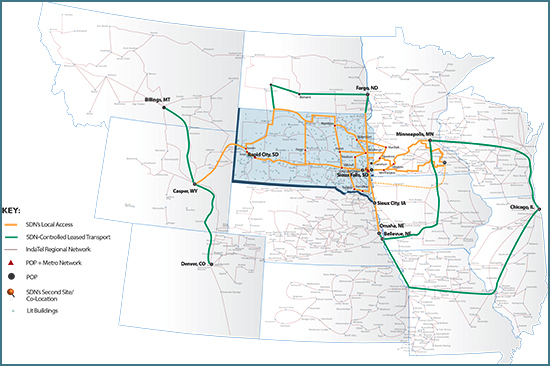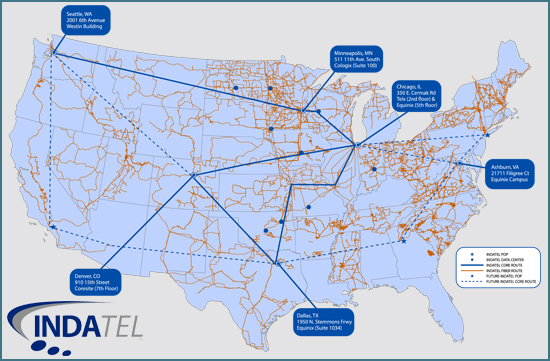
SDN Communications and its member companies connect communities across South Dakota and Minnesota with about 45,000 miles of fiber-optic lines. The network transmits voice and data quickly and reliably from border to border.
SDN’s connectivity extends far beyond states' boundaries, though.
The South Dakota-based network reaches into eight other states in the region and, from there, ties cooperatively into other networks and extends across the United States.
“We have a national reach. We have the fiber to reach any location that our customers want to reach,” said Ryan Punt, vice president of sales for SDN. “We can put multisite enterprise and multisite wholesale opportunities together because we have an extensive reach.”
SDN’s connectivity is built on three levels: local, regional and national.
LOCAL NETWORKS
The company’s reach begins locally with SDN’s network in the Sioux Falls area and the networks of 17 owner-member companies. They first came together 30 years ago and today serve approximately 90% of South Dakota’s geography. SDN’s membership is a mix of cooperatives, and privately owned, municipal and tribal systems.

REGIONAL PARTNERSHIPS
SDN and two of its member companies enhanced local telecommunications services in northwestern South Dakota by investing in the Northern Hills Transport network. SDN, Golden West Communications in Wall and West River Coop Telephone in Bison formed the network in 2006 to fill a gap in connectivity between Rapid City and Belle Fourche. The fiber routes also serve the Spearfish, Sturgis, Lead, and Deadwood communities.
The FiberComm network enhances local and regional connectivity in the Sioux City metropolitan area, which includes parts of South Dakota and Nebraska as well as Iowa. Six companies own the full-service telecommunications and data networking provider.
SDN owns 20 percent of FiberComm, which started 20 years ago with former CenturyLink infrastructure and has improved the network. Today, it connects businesses and residential customers with about 200 miles of fiber.
“We’re able to be an extension of SDN,” said FiberComm CEO Al Aymar.
SDN’s network expanded into Minnesota and Iowa 2016 when it connected seven local telecoms to form the Southern Minnesota Broadband Network. SDN manages the network that grew again in 2018 and is now made up of eight telecoms in southern Minnesota and one in northern Iowa.

NATIONALLY CONNECTED
SDN’s national transporting ability is enhanced with its membership in INDATEL, a nationwide, facility-based broadband connectivity provider with more than 400,000 miles of fiber routes. INDATEL extends SDN’s broadband services across the United States and especially to rural and underserved areas.
The INDATEL network represents 30 statewide and regional member/owners and affiliates with more than 700 independent rural exchange providers.
SDN CEO Mark Shlanta serves on INDATEL’s Board of Managers.
“The power of INDATEL comes from its fiber connectivity to places most carriers won’t go,” Shlanta says in a website testimonial. “Many of the statewide networks making up INDATEL are owned by rural telecommunications providers reaching deep into the landscape of important but sometimes hard-to-reach populations. The INDATEL membership stitches them together.”
Having good working relationships with reliable providers that can extend SDN’s reach gives the company more options in assisting clients with regional or national needs. The clients benefit by not having to deal with multiple service providers in a region or even in the nation.
“The value we bring to our enterprise customers is that we can be the single vendor to help them get to every one of their customers,” Punt said. “One company can take care of their needs so they can take care of their own business.”
SDN Communications is a regional leader in providing broadband connectivity and cybersecurity services to businesses in communities such as Sioux Falls, Rapid City, Worthington and the surrounding areas.




